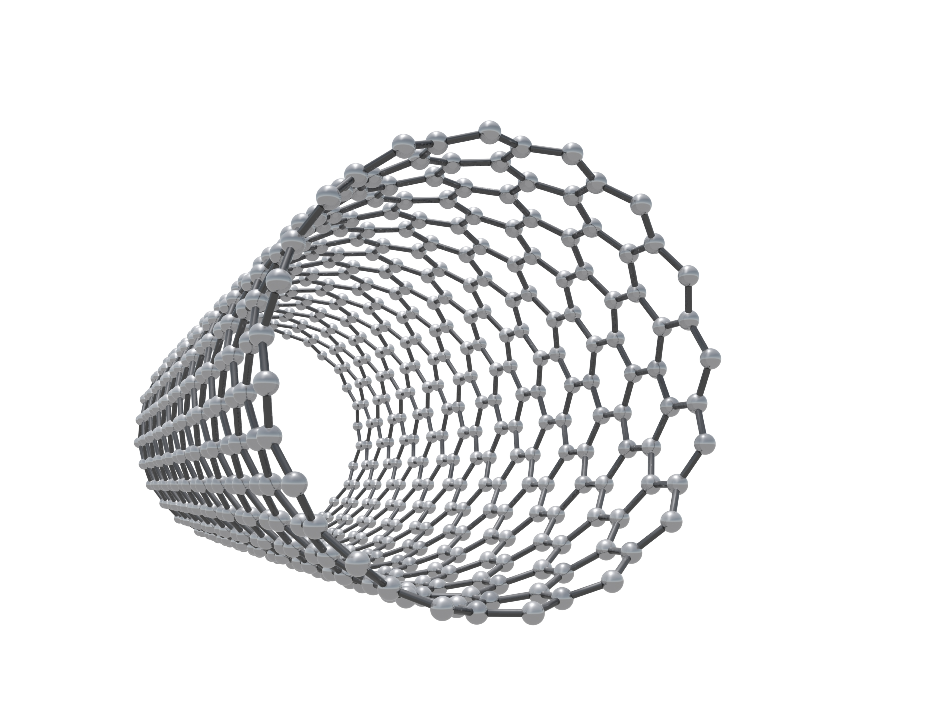Pure carbon atoms form the basis of both graphene and carbon nanotubes. Graphene is the basic structural element that forms all other carbon allotropes, including carbon nanotubes, charcoal, graphite, and fullerenes.

Image Credit: Evannovostro/Shutterstock.com
Due to the unique properties of carbon nanotubes (CNTs), their use extends to various applications in field emission, energy storage, biomedicine, industrial catalysts, adhesives, thermal materials. also due to their impressive properties of being both strong and incredibly lightweight, as well as being excellent conductors of heat and electricity.
To form a CNT, the basic form of carbon and graphene is manipulated to form thin sheets that are rolled into cylinders. The sheets of graphene used to make the nanotubes are 2D due to graphene being one atom thick, this gives the CNTs some of their special properties.
Similarities Between Graphene and Carbon Nanotubes
Graphene and carbon nanotubes have similar properties, which makes them very interesting to researchers from numerous industries. They are often both considered for use in the same applications, and as a result, scientists are now looking into combining graphene with CNTs to use them to make electronic products, sensors, batteries and more.
There are some differences between the substances, graphene as has been discussed, is 2D, whereas although they are constructed from graphene, CNTs are considered to be one-dimensional. The two also have different semiconducting properties. Single-walled carbon nanotubes have metallic or semiconducting properties, with a bandgap between zero to around 2 eV. However, attempting to use graphene as a semiconductor is problematic, because it has a zero bandgap.
In addition, working with carbon nanotubes is often seen as more difficult than working with graphene because it is challenging to position and connect them.
Production of Carbon Nanotubes
The production of carbon nanotubes is simple in theory. Single-layer graphene (one atom in thickness) is rolled into a tube to create single-walled CNTs. Other than this, layers of these graphene sheets can be rolled to create multi-walled carbon nanotubes, which have slightly different properties. Scientists have developed ways to create these materials in varying diameters and lengths so that they can use them with the specific properties they require for different applications.
Currently, there are three main methods for producing CNTs, these are known as arc discharge, laser ablation of graphite, and chemical vapor deposition (CVD). Arc discharge and laser ablation of graphite are two methods that start with graphite which is then combusted, producing a gas from which the carbon nanotubes are developed.
The most widely used method for producing CNTs is CVD, which is able to produce the nanotubes in greater quantities, at a lower cost, under conditions that are simpler to manage. The method involves combining a metal catalyst with carbon-containing reaction gases and as a result, the carbon nanotubes are formed on the catalyst within a furnace.
Purification Stage
All production methods of carbon nanotubes require a purification process to improve the purity of the created CNTs. Metal encapsulated nanoparticles, metal particles, and amorphous carbon can contaminate the nanotubes, making them lower in purity, causing structural defects and therefore modifying the nanotubes’ physicochemical properties. For this reason, a purification step is essential once the tubes have been formed. Purification can take the form of acid treatment or ultrasound performed at the end of the process.
Given the growing applications for carbon nanotubes, we can expect developments in the processes for making them too. Scientists are requiring larger volumes of pure samples for both research and commercial applications, this may drive the innovation of new and better production methods.
References and Further Reading
Graphene-info.com. (2022) Carbon nanotubes and graphene - properties, applications and market | Graphene-Info. [online] Available at: https://www.graphene-info.com/carbon-nanotubes
Disclaimer: The views expressed here are those of the author expressed in their private capacity and do not necessarily represent the views of AZoM.com Limited T/A AZoNetwork the owner and operator of this website. This disclaimer forms part of the Terms and conditions of use of this website.